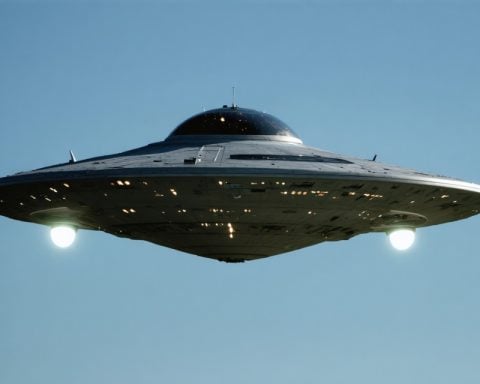In a shocking revelation, Republican Congressman Tim Burchett claims there is an unidentified object moving rapidly beneath the ocean, measuring the size of a football field. During an interview with former Florida Congressman Matt Gaetz, Burchett shared that he received this startling information from an anonymous admiral.
He emphasized that this object is travelling at hundreds of kilometers per hour underwater, sparking intense speculation regarding its origins. Burchett, who has previously accused the U.S. government of concealing evidence of extraterrestrial life, insisted that there is documented proof of this phenomenon. He reassured the American public, suggesting that if this unidentified civilization had hostile intentions, they would have already posed a significant threat.
In contrast, a March 2024 report by the Pentagon dismissed claims of UFOs, attributing many mysterious sightings to weather balloons, spy planes, and satellites instead. This contradiction highlights the ongoing debate surrounding unidentified aerial phenomena, a topic that captures both public intrigue and scientific scrutiny.
The discussion of life beyond Earth remains a hot topic globally. A recent sighting in Patagonia, Argentina, where a merchant ship reported seeing strange lights, adds fuel to the fire. While some speculate these could be Starlink satellites, investigations continue, and the mystery deepens, showcasing humanity’s enduring fascination with the possibility of extraterrestrial existence.
Beyond the Unknown: The Broader Implications of Unidentified Phenomena
The claims made by Congressman Tim Burchett regarding an astonishing underwater object highlight not only the persistent allure of extraterrestrial life but also its profound implications for society and global culture. The growing narrative around unidentified aerial phenomena (UAPs) encapsulates a worldwide search for meaning in our place in the universe. As public interest swells, it spurs a cultural renaissance in space exploration, propelling advancements in technology and scientific inquiry.
The intersection of politics, military secrecy, and public fascination has fostered a climate of mistrust toward governmental entities. This parallels trends seen in global movements advocating for transparency and accountability, suggesting a shift in how societies engage with information. The tension between official reports, like the Pentagon’s dismissals, and public testimonies amplifies this discourse, potentially impacting policy-making surrounding military and space activities.
Furthermore, the environmental repercussions of increased exploration—be it through advancements in maritime technology or outer space missions—must not be overlooked. The push for deeper oceans and distant planets could lead to unforeseen ecological consequences, urging a balanced examination of ambition and sustainability.
As humanity’s curiosity expands, so too does the potential for a long-term significance in scientific scholarship and cultural narratives. The debate surrounding these phenomena could catalyze advancements in fields ranging from astrophysics to climate science, redefining our collective trajectory in the cosmic landscape. This dialogue, far from being a mere curiosity, becomes a vital component of our shared future on Earth and beyond.
Is the Ocean Hiding Secrets? Congressman Tim Burchett’s Shocking Claims About Unidentified Objects
Introduction
The discourse surrounding unidentified objects in our skies and seas continues to captivate the public’s imagination, especially in light of recent statements made by Republican Congressman Tim Burchett. Burchett’s assertions about a massive unidentified object moving swiftly underwater have reignited discussions about the existence of extraterrestrial life and advanced technologies lurking in the depths of our oceans.
Overview of the Claims
During a candid interview with former Congressman Matt Gaetz, Burchett revealed that an anonymous admiral provided him with startling details about an object measuring the size of a football field and traveling at speeds of hundreds of kilometers per hour beneath the ocean surface. This bold claim has fueled speculation about the object’s origins and whether it might be linked to advanced technologies not disclosed to the public.
Burchett has been a vocal critic of the U.S. government’s transparency regarding unidentified aerial phenomena (UAPs). He has previously claimed that there is substantial documentation supporting the existence of such phenomena and reassured the public that if this unidentified civilization had malevolent motives, we would have already faced significant threats.
Pentagon’s Response
In a stark contrast to Burchett’s claims, a March 2024 Pentagon report addressed the topic of UAPs, largely downplaying the idea of extraterrestrial origins. The report attributed many sightings to more mundane explanations such as weather phenomena, military spy planes, and satellite activities. This juxtaposition of Burchett’s assertions and the Pentagon’s dismissal showcases the ongoing tensions and varying perspectives surrounding unidentified phenomena, captivating both skeptics and enthusiasts alike.
Global Reluctance for Disclosure
The conversations initiated by Burchett’s comments highlight a broader trend of public curiosity regarding life beyond Earth. Beyond the political discourse, a recent incident in Patagonia, Argentina, where a merchant ship reported strange lights in the sky, adds another layer of intrigue. While some speculate these sightings could be attributed to Starlink satellites, investigations continue, underscoring humanity’s relentless quest for understanding its place in the universe.
Features of UAP Discussions
1. Public Fascination: The intrigue surrounding UAP sightings and potential extraterrestrial life remains a hot topic, inspiring numerous documentaries, books, and scientific inquiries.
2. Scientific Scrutiny: As more sightings emerge, scientists are increasingly involved in analyzing UAP reports, contributing to the legitimacy of the discussions.
3. Technological Advancements: The capability of advanced technology, such as satellite surveillance and high-resolution imaging, has improved the study of UAP phenomena.
Pros and Cons of UAP Disclosure
Pros:
– Increased Transparency: Greater government transparency could restore public trust and encourage scientific investigation into unidentified phenomena.
– Potential Discoveries: Exploring UAPs may lead to new scientific breakthroughs or technologies that could revolutionize our understanding of physics and engineering.
Cons:
– National Security Concerns: Disclosure might raise fears about security threats, particularly if these phenomena are linked to foreign technology or hostile entities.
– Misinformation: The potential for misinformation is high, as sensationalism can overshadow factual scientific inquiry.
Conclusion
The debate surrounding unidentified objects, both aerial and submerged, continues to evolve, driven by claims such as those made by Congressman Burchett and the contrasting responses from authorities like the Pentagon. As investigations persist and public interest remains high, the narrative of UFO and UAP sightings appears far from resolution, holding the potential for future revelations that could reshape our understanding of life beyond Earth.
For more insights into UAPs and ongoing discussions related to extraterrestrial life, visit NASA’s official site.



















